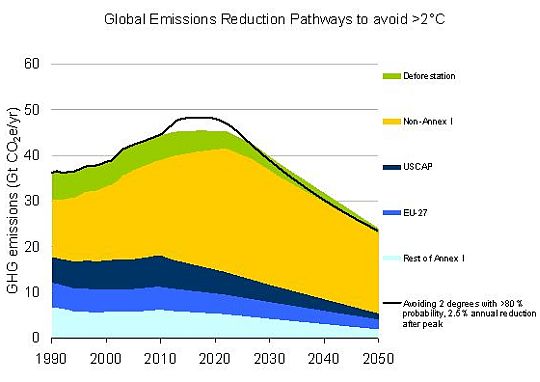There’s been a lot of buzz lately about the U.S. Climate Action Partnership and its new blueprint for a cap on global warming pollution. Last week, the diverse group of environmental nonprofits and leading companies from every sector of the U.S. economy unveiled a detailed plan for legislation — the consensus product of two years of intense analysis and debate.
As a consensus document, it won’t satisfy everyone’s design for the perfect climate bill. Instead, it bridges the gap on the most important issues in the legislative debate, giving members of Congress clear guidelines for legislation that are environmentally effective, economically smart, and politically achievable.
It’s an attempt to find the “sweet spot” that can move the U.S. forward on climate change, in real, practical terms, toward a strong domestic emissions cap that reduces pollution at home and enables the U.S. to lead an effective global emissions reduction effort.
Any U.S. climate proposal needs to be examined in that context. After all, even the strongest U.S. legislation alone won’t secure enough global emissions reductions to solve climate change. What we need right now is strong domestic action that drives international action and contributes effectively to a global emissions reduction path that can avert the worst impacts of climate change.
The two-degree threshold
Scientific experts say that our emissions path must keep global warming within 2° of pre-industrial levels. Beyond that, the chances of catastrophic climate impacts increase dramatically. Would the USCAP blueprint as a whole contribute effectively to the global emissions reductions we need? The chart below shows that it would.

The black line on this chart represents a global emissions pathway that provides a greater than 80 percent likelihood of avoiding a long-term warming of 2°C above the pre-industrial level. This is a concentration “peaking” pathway that brings greenhouse gas concentrations back down toward current levels after peaking at a higher level, unlike the conventional “stabilization” pathways that hold concentrations at an elevated level indefinitely into the future. Thus, this pathway allows for higher emissions in the near-term for the same temperature goal, but requires greater reductions in the long-term.
Further details can be found in EDF’s in-depth analysis document [PDF].
The “layer cake” below the black line shows one way of allocating emissions reduction responsibility among countries and regions to meet the 2° constraint. Along with the aggressive end of the USCAP targets for the U.S., we assumed a reduction of 60 percent below 1990 level by 2050 for the E.U. (in line with recent announcements) and a comparable target for Russia. We also assumed that tropical forest nations will take action to reduce their deforestation emissions. Then we divided up the remaining atmospheric space among developing countries, based on an attempt to bring per capita emissions to a roughly uniform level across all countries of the world by 2050.
The allocation of emissions depicted in this chart is not the only scenario that gets us to 2°. But it does show how the USCAP targets fit into a global effort that limits warming below 2°, while allowing developing countries room to grow.
The U.S. needs to lead
The single most important thing the U.S. can do to drive international action is to adopt a mandatory cap on emissions, with targets and timetable consistent with an effective global effort to avoid 2° of warming.
USCAP passes the test on both counts: It helps unlock the door for Congress and the Obama administration to act quickly and with confidence that a well-designed cap-and-trade program will be environmentally strong and economically sound; and the emissions reductions it would achieve support a global effort to avoid dangerous warming.
To quote from the blueprint itself: “U.S. leadership is essential for establishing an equitable and effective international policy framework for robust action by all major emitting countries. USCAP believes that adoption of mandatory U.S. climate policy is an essential precondition for a full and effective international framework.”
The blueprint for legislative action is a huge step toward that goal. USCAP’s members have united around this nonpartisan plan because of the urgent need for climate action — by this Congress — and because an effective, economy-wide cap-and-trade program will position the U.S. to lead a global solution.

